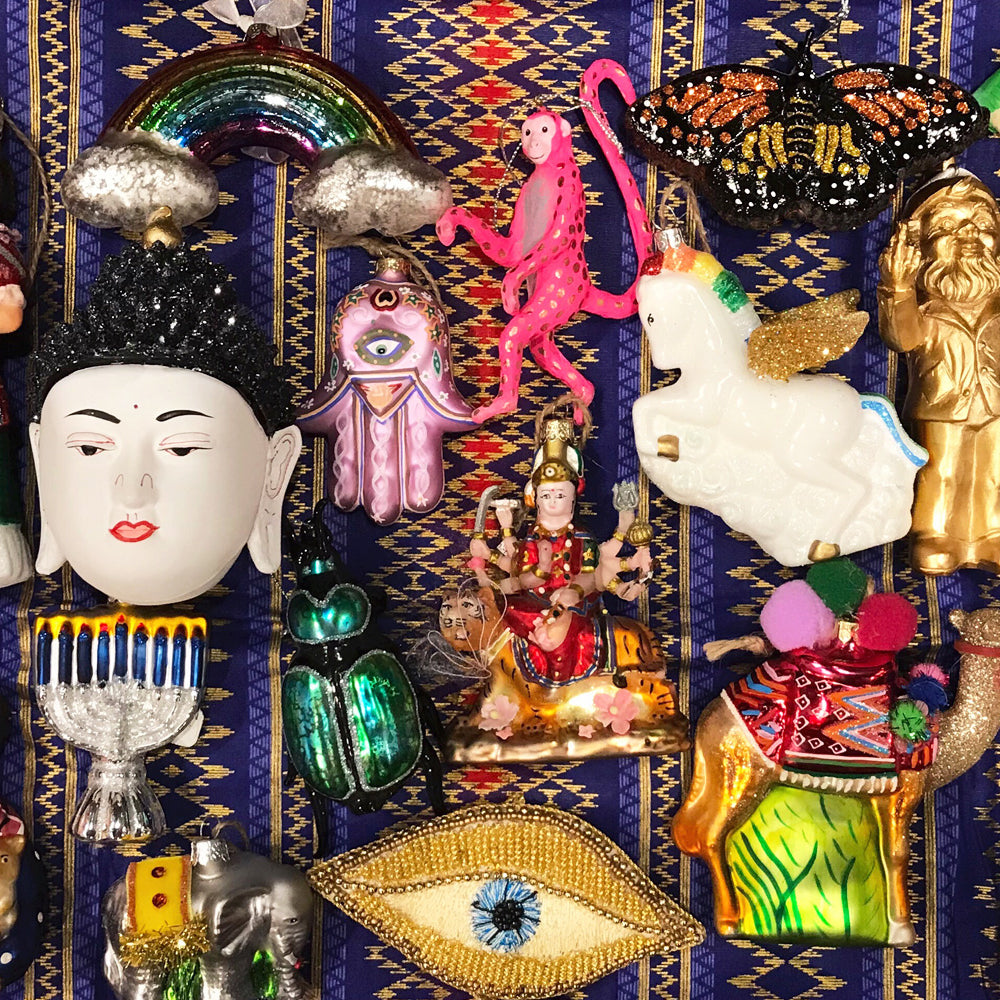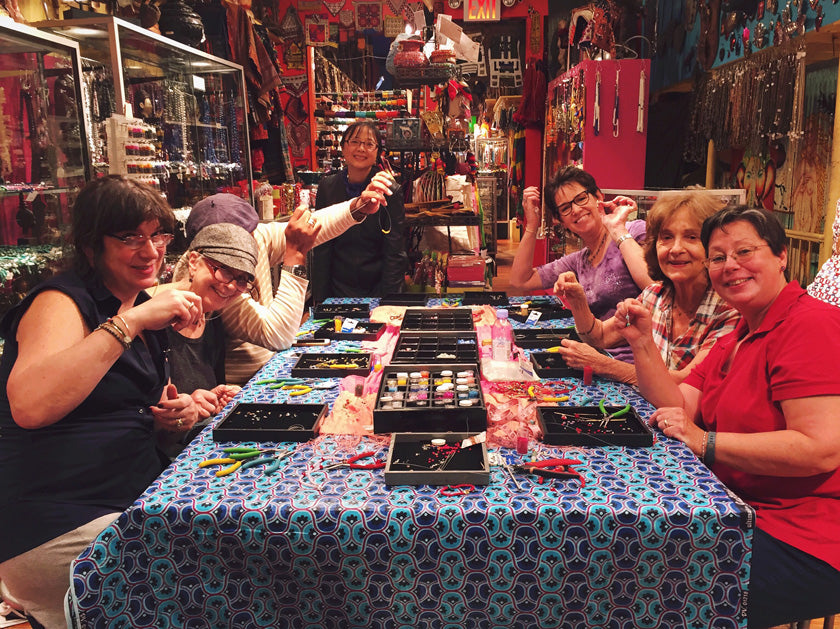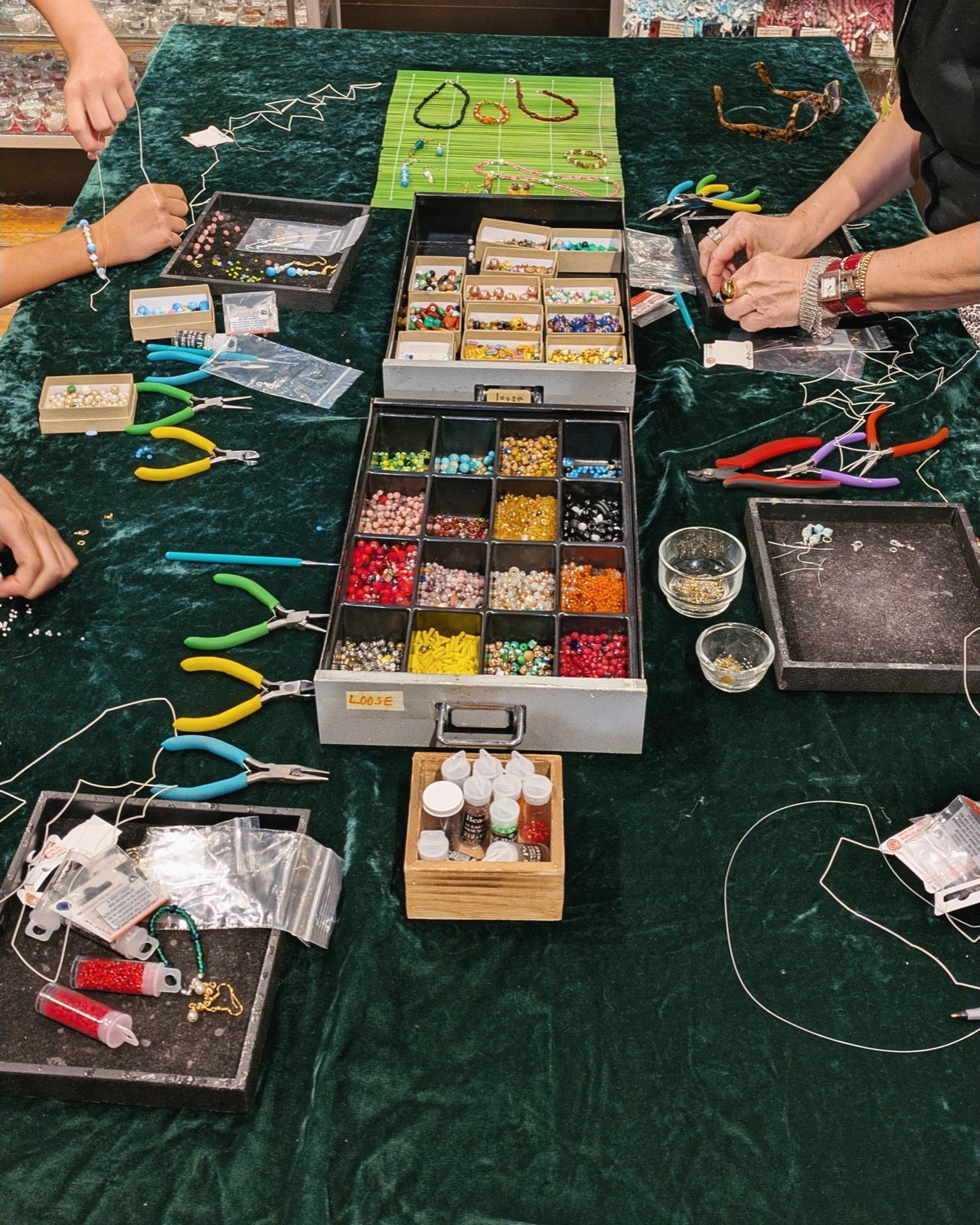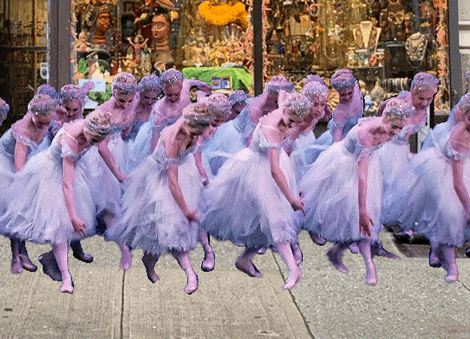Gemstone Properties

We get some of our biggest oohs and ahhs when people step into the back of the shop and catch sight of our tall, glimmering cases filled to the brim with gemstones of every color of the rainbow. They are, without a doubt, a truly breathtaking reminder of the scope of color in Mother Nature. Some individuals are content to let their eyes lead them, while others are looking for stones with a particular meaning. Though we have a selection of books behind the counter that we'd be happy to pull out for you, we thought we'd compile our own guide to gemstone history, background and lore for you to peruse right here. If there is a link imbedded in the gemstone's name then you can follow it to shop products with that gemstone online; our website, however, is not always indicative of our entire store's stock, so don't hesitate to ask or pop in if you're looking for something in particular!
Agate
Agate is a type of chalcedony in the quartz family, which often occurs in nodular masses in volcanic lava rocks. They form in concentric layers and bands similar to tree trunks and may appear as eyes, scallops, or visually resemble landscapes. It is the official gemstone/ mineral of several states within the USA. The folklore of many ancient civilizations rumors that wearing agate would protect from danger. It was often used on the breastplates of soldier's armor to give warriors strength and make them victorious in battle. Agate was thought of as the stone of strength in the ancient cultures. Roman farmers believed Moss Agates to ensure good crops and to please the gods that would bring an abundant harvest. In ancient Asia, magicians believed that agates might be used to see the future, ward off evil, and to divert dangerous storms . Early Britons believed the stone might prevent skin disease. Agate talismans were worn in the Middle East and believed to keep the blood healthy and sucking on an agate was thought to relieve thirst. Another legend says that any person who looks upon an agate can not remain secretive and is obligated to tell the truth. Agate is commonly found in folklore to induce calming, aid in protection, and promoting a balanced body energy.
Alexandrite
Amazonite
Amazonite is a bluish-green stone of the feldspar family usually seen with white streaks running throughout the stone. Amazonite displays a schiller of light which is caused by inclusions. Schiller is a lustrous reflection from planes in a mineral grain and is similar to what is more commonly known as iridescence. The green color is traditionally thought to come from the presence of copper as the Amazonite crystals form. Although it is named after the Amazon River, Amazonite is found in Russia, Madagascar, Brazil, and Colorado. In stone folklore, Amazonite represents a balance between masculine and feminine energy; Amazonite is rumored as a symbol of balance between masculine aggression and feminine values, and promotes kindness and practicality, inner power and courage.
Amber
Amethyst
Ametrine
Ametrine is a naturally occurring variety of quartz that combines both Amethyst and Citrine. Color zones of violet amethyst to golden yellow citrine are visible within Ametrine , and are due to differing oxidation states of iron within the crystal. The different oxidation states occur due to there being a temperature gradient across the crystal during its formation. Almost all Ametrine comes from Bolivia, although there are a few small pockets in India and Brazil. It is believed in stone folklore to stimulate the intellect and banish negative energy.
See Ametrine jewelry here.
Andalusite
Andalusite is named after Andalusia, Spain, where it is predominately found. It is also mined in Brazil and Sri Lanka. It is a polymorph with two other minerals: kyanite and sillimanite. Andalusite displays shades of yellow, olive and reddish brown depending on the orientation of the crystal colors, and has a muted form of iridescence. Andalusite is associated with mica schist.
Andalusite is also sometimes called “The Seeing Stone,” and contemporary folklore rumors Andalusite helps one look at things objectively and without bias, and to improve memory.
Apatite
Most apatite is found in Brazil, Burma, and Mexico. Its unique crystal structure makes it softer than other stones, and is one gemstone mineral which is actually produced and used by the human body. From the point of view of mineralogy, apatite is a group of phosphate minerals, and large amounts of apatite are in human bones and smaller amounts are in rocks. Apatite and apatite-like minerals make up most of our teeth and bones
Apatite-rich rock is also the most important source of phosphorus in the world. Apatite is considered in stone folklore a great balancing stone and is thought to promote health and strength of teeth and bones.
Aquamarine
Aquamarine is the blue stone in the beryl family and gets its name from Latin words meaning water and sea.While it is found all over the world, the best aquamarines come from Columbia and Brazil. The gemstone Aquamarine is the modern March birthstone. It is also the birth stone for the Zodiac sign of Scorpio.
Ancient aquamarine crystals have been found in Egyptian mummy tombs. Aquamarine is commonly associated with water, and folklore tells that sailors would carry it for protection at sea to keep them safe and prevent seasickness. It is also rumored a wonderful meditation stone.
Aventurine
Aventurine is a form of quartz, characterized by its translucency and the presence of platy mineral inclusions that form when quartz is subjected to heat and pressure, causing it to melt and resolidify with other minerals. This formation process gives a shimmering or glistening effect termed "aventurescence." The most common colour of aventurine is green, but it may also be orange, brown, yellow, blue, or gray. Chrome-bearing Fuschite (a variety of Muscovite Mica) is the classic inclusion, and gives a silvery green or blue sheen. While it is most often green, it also appears in orange, brown, yellow, blue, and grey. Its name comes from Italian, “a ventura,” meaning “by chance.” While most blue and green aventurine comes from India, the other colors are found in Chile, Spain, and Russia. In contemporary stone lore, Aventurine is considered a healing stone to soothe a troubled heart or calm distraught emotions.
Azurite
Azurite is formed from the oxidization of copper ores.It often occurs with Malachite, Chrysocolla and Turquoise in areas with copper deposits. A rare form called "Bluebird", has dark red Cuprite mixed with Azurite.
Azurite is found in Australia, Chile, France, Mexico, Morocco, Nambia, the southwestern USA, and Zaire. For thousands of years this stone has been used in jewelry and ornamental objects. During the Middle Ages and Renaissance it was ground into pigment for use in paint and eye shadow Its mixture of blue and green resembles the planet earth. In contemporary stone lore, Azurite is thought to enhance creativity, reduce anger and stimulate the pursuit of the heavenly self and psychic awareness.
Beryl
Bloodstone
Bloodstone is an opaque dark-green form of Chalcedony quartz with distinctive red spots, which are caused by the presence of iron oxide. Bloodstone is also known by the name Heliotrope, perhaps because in ancient times the color was reminiscent of reflections from the setting sun. The name bloodstone obviously comes from the resemblance to blood of the red droplets.Early Christian legend is that when Jesus Christ was crucified, the dripping blood stained the green Jasper at his feet, and this was the origin of Bloodstone. Bloodstone was widely used in sculptures representing flagellation and martyrdom, and was known at one time as the "Martyr's Stone". There are also some gemological myths associated with Bloodstone. In the gem trade, the term blood jasper is sometimes used to refer to Bloodstone. Many apparently reputable sources describe bloodstone as a form of green Jasper, or as containing red Jasper. But according to the most authoritative sources, Bloodstone is not a Jasper at all. Bloodstone was the original birthstone for March but has been replaced by Aquamarine. However, Bloodstone is still regarded as the astrological gem for Aries. The largest Bloodstone deposits are in India. Some believe the reason for the shortage of high quality Bloodstone is due to the fact that finely powdered Bloodstone is used as both a medicine and an aphrodisiac in India. Due to its name and appearance, many myths became associated with Bloodstone. It was once thought in folklore to be able to stop hemorrhages with the merest touch, and to relieve stomach and bowel pain. It was said to strengthen blood purifying organs and improve blood circulation.
Blue Lace Agate
Blue lace agate is the banded form of blue Chalcedony. It was discovered in Namibia by George Swanson. He originally called it the “gem of ecology,” due to its resemblance to the clouds. Blue Lace Agate is a gentle, calming stone. It also according to stone lore rumored ease communication, enhance conversation, and helps one during public speaking.
Blue Topaz
Topaz comes from the Greek word, “topazos,” meaning “to seek". Topaz is the birthstone of November (yellow topaz) and December (blue topaz), and it is a talisman for the sign of Sagittarius Most topaz comes from Brazil. Blue topaz can be found in both lighter and darker tones, usually known in the trade as Sky Blue Topaz, Swiss Blue Topaz and London Blue Topaz. As in the case of other blue gems, the more saturated blues tend to have a higher value. So in topaz it is the London Blue that usually regarded as the most valuable.
Boulder Opal
First discovered in Quilpie, in Western Queensland Australia in about 1870, the Boulder Opal is found embedded in ironstone boulders. The opal usually forms as thin veins within these boulders, and most stones are cut to include some of the host ironstone matrix. Boulder opal is sometimes referred to as Opal in matrix for this reason.
See Boulder Opal jewelry here.
Calcite
The word calcite comes from the latin word calx, and the Greek word chalix, meaning "lime". Calcite is common in limestone and marble. Optical (clear) calcite has double refraction. If you lay it over a line of writing, you will see the writing show up in two lines through the calcite. Calcite is often colored by various impurities, including iron, magnesium, manganese, zinc or cobalt and occurs in a range of colors including white, gray, yellow, green, red and blue. Calcite is found in Mexico and the southwestern United States and is found also in caves and caverns as stalactite and stalagmite formations. Folklore rumors calcite to enhance learning abilities, and thus is a popular stone for students; in general it is thought as a grounding and centering stone.Carnelian
Carnelian is an orange Chalcedony that comes from the Latin word, “caro,” meaning “flesh”. The distinctive red-orange color of Carnelian is a result of trace amounts of iron. Sometimes the name Sard is used to refer to the darker colors of carnelian. Carnelian is one of the birthstones listed in the ancient Arabic, Hebrew, Italian and Roman tables and is a Zodiac birthstone for the signs of Leo and Virgo. Carnelian has one of the oldest known gemstone histories. It was widely used in ancient Rome to make signet or seal rings for imprinting a seal on letters or important documents (hot wax does not stick to carnelian). Folklore suggests that Carnelian's healing properties help purify the blood, relieve menstrual cramps and back pain. It is also thought to be beneficial in the treatment of infertility and is worn to enhance passion and desire.Chalcedony
Chalcedony is used as a variety name to refer specifically to the bluish-gray or lavender color of cryptocrystalline quartz. This color is sometimes called "Actual Chalcedony" but the name can be slightly confusing, as most of the other Chalcedonies are referred to by other names, such as Agate, Bloodstone or Carnelian.Charoite
Discovered in Russia in 1978 in the Murun mountains in Yakutia, Siberia. This the only known location for this rare mineral. The name Charoite is derived from the Charo River which is near where it was found.Chiastolite
Chiastolite is a form of andalusite. It is also known as the “cross stone,” or “piedra de cruz,” due to its cross-like inclusions of graphite. Its name comes from the Greek word, “chiastos,” for “cross-marked.” Chiastolite has been used since ancient times for protection. Contemporary stone lore rumors that Chiastolite is also worn for balance and harmony, and is thought to enhance the intellect.Chrysocolla
Chrysocolla is a blue-green mineral that contains copper. One of the interesting features of Chrysocolla is that it is often found mixed with other secondary copper minerals such as Malachite, Azurite and Turquoise or with quartz. These mixtures provide interesting patterns and textures, and also make the final product harder and more durable than pure Chrysocolla.
Chrysoberyl
Chrysoberyl has been known since ancient times and the name comes from the Greek word for gold. Its most famous varieties include Alexandrite, named after Czar Alexander II, and Chrysoberyl Cat's Eye (Cymophane). Chyrsoberyl is a very hard gem, rating 8.5 on the Mohs Hardness Scale right behind Corundum and Diamond. Despite its similar name, Chrysoberyl is not a member of the Beryl family. Chrysoberyl is usually found in golden yellow, yellowish-green to green, yellow, as well as shades of brown and red. Notable Chrysoberyl deposits are in Brazil, Madagascar, Myanmar, Russia, and United States. Obscure folklore rumors Chrysoberyl's golden color inspires good mood, generosity and a kind disposition.Chrysoprase
Chrysoprase is the green variety of Chalcedony that is found mainly in Australia. Trace amounts of nickel give Chrysoprase its apple green color. Chrysoprase is one of the Star Signs for Gemini. It is found in Australia, Brazil, the Ural Mountains, and the U.S. and is the rarest of the Chalcedony group.
Citrine
The gemstone Citrine is the official birthstone for the month of November. Citrine is a type of quartz that ranges from light yellow to golden-brown. It comes from the Latin word, “citrine,” meaning “yellow.” Most citrine is mined in Brazil. In contemporary stone lore, Citrine is known as the “Success Stone” or the "Merchant's Stone" because it is rumored to bring success, prosperity and abundance. Also citrine is rumored to dispel negative energy.
Coral
Coral is created by millions of small organisms at the bottom of the ocean called polyps. Each polyp builds up a limestone case around itself, which remains after it dies. The casing becomes the basis for another polyp to build its home. Slowly, after thousands of years, these casings build up into what we know as a coral reef. Historically, material from these reefs were highly prized, and used to make jewelry and other ornamental objects. However, because removing coral from these reefs is bad for ocean environments, there are strict regulations against removing coral from the ocean. Most coral used today is grown in coral farms, rather than being taking from the ocean. Most precious coral is harvested in the Mediterranean Sea, especially in Sardinia. Deposits are also found in the Pacific, in Japan, Taiwan and Australia. In contemporary stone lore, Coral is rumored to stimulate emotional healing and relieves stress.Diamond
A diamond is composed entirely of carbon. It is the hardest natural material on the planet, and comes from the Greek word for “unbreakable.” Diamonds form roughly 100 miles deep into the Earth’s mantle, and rise to the surface through volcanic eruptions. Diamonds are graded on the four C’s: cut, color, carat, and clarity. Diamonds are considered one of the four Precious Stones; the Sapphire, the Emerald, the Ruby and the Diamond. They are associated with longevity, particularly when it comes to relationships, which makes them perfect for engagement rings and gifts of love.Emerald
Emerald is the Modern and Traditional birthstone for May. Emerald is the only stone besides Topaz that is listed in all of the ancient birthstone tables. Emerald is the most precious stone in the Beryl group. The name Emerald comes from the Greek "smaragdos" via the Old French "esmeralde", and really just means 'green gemstone.' Emerald's precious green color is caused by trace amounts of chromium and vanadium. Emeralds are considered one of the four Precious Stones; the Sapphire, the Emerald, the Ruby and the Diamond.Emeralds are found in many countries, but Columbia and Brazil are the major producers; Columbia is recognized as the source for the finest stones. They are also found in Pakistan, Russia, Australia, South Africa, India, Norway, and the United States.
Incas and Aztecs of South America, where the best emeralds are still found today, regarded the emerald as a holy gemstone. However, probably the oldest known finds were once made near the Red Sea in Egypt. These gemstone mines, already exploited by Egyptian pharaohs between 3000 and 1500 B.C. and later referred to as 'Cleopatra's Mines', had already been exhausted by the time the mines were rediscovered in the early 19th century.
Written many centuries ago, the Vedas, the holy scriptures of India, say the emerald enhances the well-being, and are supposed to aid in fertility and abundance. Commonly today, they are closely associated with love and gifts of love.
Fluorite
Fluorite is a mineral with a range of brilliant colors from purple, blue, green, yellow, colorless, brown, and pink. Most specimens of Fluorite have a single color, but a significant percentage of Fluorites have multiple colors and the colors are arranged in bands or zones. Fluorite is a relatively soft stone which is easy to carve. The origin of the word Fluorite comes from the Latin verb to flow. Ancient Romans believed that drinking alcoholic beverages from vessels carved of Fluorite prevented drunkenness. Fluorite is also used as a source of fluorine for fluorinated water. It is rumored that Fluorite stones have a calming effect on the body.
Garnet
The gemstone Garnet is the official birthstone for January and is also the stone for the Zodiac sign Aquarius. The name Garnet comes from the Latin word "granatus", which means grain, because many garnet deposits are small grains of red crystals in their host rock. Garnet refers to a group of minerals that can appear in any color.Some of the main Garnet types are: Rhodolite – purple; Hessonite – brown/orange; Spessartite – red; Mandarine – orange; Demantoid – light green; and Tsavorite – dark green. The highest-quality Garnets are found in Brazil, China, Kenya, Madagascar, Pakistan, Sri Lanka, Tanzania and the United States.
According to traditional stone lore, red/purple Garnets are associated with love, friendship, and controlling one’s anger; green Garnets with peace and serenity; and orange Garnets with creativity.
Goldstone
Goldstone is a manmade glass with flecks of copper suspended in it.The process was invented and patented by the Miotti family in 17th century Venice. Today, coloring agents can be added to the mix to make goldstone in different colors. Goldstone is associated with the same metaphysical properties as copper, and is believed to aid the circulatory system.Hematite
Hematite is the mineral form of iron, and is mined as the main ore of iron. The name Hematite is derived from the Greek word for blood, because Hematite can be red (as in jewelers' polishing rouge, a powdered form of hematite). The color of Hematite lends itself well in use as a pigment. It is usually formed in places with standing water or hot springs, such as the western United States. Hematite can also occur without water, however, usually as the result of volcanic activity. Hematite is a harder substance than pure iron, but is much more brittle and can sometimes be magnetized. Hematite has also been found on the planet Mars by NASA spacecraft. Since Hematite is usually found in aqueous environments on Earth, it has led to speculation that there was once water on Mars. Folklore rumors that Hematite is associated with grounding, balance, and protection.Hypersthene
Hypersthene is a mineral that has a color range in grey, brown, and green. It comes from the Greek for “over strength”. The coarse-grained Labradorite- Hypersthene rock (Norite) of the island of Paul off the coast of Labrador has furnished the most typical material. Hypersthene is rumored in stone lore for its ability to provide answers to problems and combat irritability.Herkimer Diamonds
Iolite
The name Iolite comes from the Greek ios, which means violet. The Vikings possibly mined Iolite crystals from deposits in Norway and Greenland. Viking sailors allegedly used Iolite as a polarizing filter to find the sun on cloudy days for a safe offshore navigation. The Viking sailors allegedly used thin pieces of Iolite as a lens, and the folklore surrounding this idea says they could determine the exact position of the sun on cloudy days, and navigate safely to their new worlds and back.Iolite is a stone that forms most often with Granite, and is found mainly in Sri Lanka, India, and Burma. It is associated in folklore and stone lore with vision, both in terms of eyesight and intuition, as well as expression and clarity of emotions.
Jade
Since prehistoric times, Jade was used in many parts of the world for arms and tools because of its exceptional toughness. For over 2,000 years, Jade had religious significance in China and mystic figures and other symbols were carved from it. In the pre-Columbian period, the Mayas, Aztecs and Olmecs of Central America honored and esteemed Jade more highly than gold.Jadeite first came to China from Burma in the 18th century. Before the introduction of Jadeite, the Chinese tended to value translucent white Nephrite. But the Jadeite from Burma came in a wider range of colors, including green, lavender, yellow, black and white. The rarest and most valuable Jadeite is the emerald green Imperial Jade, colored by traces of chromium. It has color and transparency rivaling fine Emerald, though Imperial Jade is slightly more yellow in tone. In fact the revered Emerald Buddha in Wat Phra Keow in Bangkok is believed to be composed of fine Jadeite, not Emerald. Although Jade is traditionally thought of as green, it is also found in white, blue, and lavender.
New Zealand's Maoris began carving weapons and cult instruments from native Jade in early times, a tradition which has continued to the present day. In ancient Egypt, Jade was admired as the stone of love, inner peace, harmony and balance. As early as 3000 B.C. Jade was known in China as "Yu", the "Royal Gem". In the long history of the art and culture of the Chinese empire, Jade has always had a very special significance, comparable with that of gold and Diamonds in the West. Today, too, this gem is regarded as a symbol of the good, the beautiful and the precious. In folklore, Jade embodies the Confucian virtues of wisdom, justice, compassion, modesty and courage, yet it also symbolizes the female-erotic. Jade is also believed to be a lucky stone, and provides good health, prosperity. It is rumored that slipping a peace of Jade under one’s pillow can enhance dreams.
Jasper
Jasper is an opaque form of Chalcedony. It usually comes in shades of red, yellow, brown, and green, although there are rare forms of blue Jasper. It often contains organic material and mineral oxides which give it interesting patterns, bands, stripes and colors. Many of these patterns resemble landscapes with mountains and valleys, thus the name "picture" is part of the name of many well know Jaspers. The name comes from Old French meaning “spotted or speckled,” and it is found all over the world. Jasper was a favorite gem in ancient times, and was believed to be protective, and ward off evil spirits. In folk medicine, it is rumored to be of help for sciatica and troubled toenails.Jet
Jet is a form of fossilized wood similar to coal, but harder. Jet is dark brown or black in color, and can have Pyrite inclusions. Jet as a gemstone was fashionable during the reign of Queen Victoria, during which the Queen wore Whitby (North Yorkshire, England) Jett as part of her mourning dress. Jet was associated with mourning jewelry in the 19th century because of its sombre colour and modest appearance, and it has been traditionally fashioned into rosaries for monks. In the United States, long necklaces of Jet beads were very popular during the 1920s. Sometime Jet is referred to as “black Amber,” although it actually has no relation to Amber, but similarly produces a pleasant electrostatic charge when rubbed. Historically, and even in modern stone lore, Jet is a powerful protective stone, that wards off all types of evil and absorbs negative energy, keeping the wearer safe.Kunzite
Kunzite is a pink to lilac stone in the spodumene family. Kunzite is named as a tribute to George F. Kunz, the legendary American mineralogist and buyer for Tiffany & Co, who first described the gem in 1902. It is important to keep Kunzite out of extreme sunlight, as its color can fade. Kunzite is found in Brazil, North America, Sweden, and Afghanistan. Contemporary stone lore rumors Kunzite to combat feelings of loneliness and depression,and can help to understand and interact better with others.Kyanite
Kyanite is named after the Greek word for "blue". Very fine Kyanite can have a near Sapphire-blue color, but also can be found in a range of white, gray, green or yellow. Color is often not consistent throughout many examples, often showing white streaks in a medium blue. Luster is vitreous (glassy) to almost pearly. It is found across the world, with large pockets in Brazil, Kenya, Switzerland, Australia, and New England. Kyanite in stone lore is rumored to aid in communication and expressing oneself, and to better embrace love and relationships.
Labradorite
Labradorite is an iridescent gemstone with a beautiful schiller or metallic luster when viewed from certain angles. A member of the plagioclase feldspar group along with Sunstone, Labradorite is known as a smokey grayish/green mineral base that creates an amazing metallic rainbow, referred to as "labradorescence". Labradorite was named after the Labrador Peninsula in eastern Canada where it was first found around 1770. Deposits have also been found in Australia, Finland, Madagascar, India, Mexico and the Adirondack Mountains in the United States. In stone lore, Labradorite is rumored to dispel negative energy, ease anxiety and feelings of depression, and enhance intuition and self confidence during difficult times.Lapis Lazuli
Lapis has been used for more than 6000 years for fine jewelry and ornamental objects. Its name is from "lapis" the Latin word for stone, and "azul," the word commonly meaning blue. Lapis Lazuli is made up of 25 to 40 percent lazurite, plus several minerals (Sodalite, Hauyne, Calcite, and Pyrite) that influence color and its distribution. Lapis Lazuli is considered a semi-precious stone and is found throughout the Middle East, most specifically Egypt and Afghanistan. Because of its bright blue color, Lapis Lazuli was ground up to make paint and dye pigments. Prior to the 19th century, it was used as the pigment ultramarine in tempra, and oil paints. Ancient Egyptian nobility such as Cleopatra used finely ground lapis as eye shadow. Lapis Lazuli is commonly mentioned in folklore as the stone for truth and friendship, as well as emotional healing.Larimar
Lepidolite
Malachite
Malachite is a basic copper carbonate that is formed from copper-containing solutions near copper ore deposits. The name Malachite comes from a Greek word for “mallow-green,” because the distinct color resembles the leaves of the mallow plant. Malachite was used as a mineral pigment in green paints from antiquity until about 1800.Moldavite*
Moldavite is an olive-green substance believed to have been formed through a meteor impact that happened 15 million years ago and is considered a type of Tektite (natural glass rocks up to a few centimeters in size, which most scientists argue were formed by the impact of large meteorites on Earth's surface). Tektites are among the "driest" rocks, with an average water content of 0.005%. This is very unusual, as most if not all of the craters where Tektites may have formed were underwater before impact. This suggests that the Tektites were formed under phenomenal temperature and pressure not normally found on the surface of the Earth. The first Tektites were found in 1787 in the Moldau River, hence their original name of "moldavites." Other color varieties of this natural glass have since been found in many different localities but the Moldau River in the Czech Republic is now the only known locality for green, transparent Tektite. Tektites are usually translucent and occur in a range of colors from green to brown. Their surfaces are usually uneven or rough, with a distinctive lumpy, jagged, or scarred texture. Tektites do not contain the crystallites found in Obsidian.
The age of Moldavites, a type of Tektite found in the Czech Republic, was determined to be 14 million years, which agrees well with the age determined for the Nordinger Ries crater (a few hundred kilometers away in Germany). Similar agreements exist between Tektites from the North American strewnfield and the Chesapeake Bay impact crater and between Tektites from the Ivory Coast strewnfield and the Lake Bosumtwi Crater. Tektites from Thailand have been carved as small, decorative objects worn in the belief that they give protection from evil.The estimated amount of Moldavite in existence is only 275 tons.Moldavite Tektite is famed as an important New Age crystal, rumored to encourage spiritual awareness, and connection with both higher realms and extraterrestrial communication. More common contemporary stone lore rumors Moldavite as stone of communication, and helps to release inner demons.
* We occasionally have Moldavite in the store, even fi they are not online. Get it touch with us to see if we have any available.
Moonstone
Moonstone owes its name to the white, almost magical shimmer that resembles moonshine. Gemologists call this phenomena adularescence, which originates from the interior structure of the gemstone in scales,exhibiting multicolor flashes. Moonstone can range from colorless to blue, peach, violet, green, pink or gray with a silvery scheen. This iridescence is known as a "schiller", but in moonstone it is called adularescence. Clarity ranges from transparent to translucent.Moonstone is one of the modern June birthstones and an accepted gem for the 13th wedding anniversary. Moonstone is found in Australia, the United States, Madagascar, Mexico, and Sri Lanka. This gemstone was extremely popular in the times of "Art Nouveau", more than 100 years ago. Moonstone was used to decorate a striking amount of pieces of jewelry created by the famous French master-goldsmith René Lalique and his contemporaries. Old legends say Moonstone was used in jewelry by the Romans who believed that the stone was formed from the light of the moon. Moonstone is considered by many a sacred stone in India. Traditional stone lore rumors Moonstones have a deep connection with women, and aides in balancing hormones, helps relieve PMS, increases fertility, and eases the pain of childbirth. For men, it's said to help in opening up one’s emotional self.
Morganite
Morganite is a pink/purple stone in the Beryl family. It was first discovered in Madagascar in 1910. In the first decade of the twentieth century, several new gemstone varieties were discovered in Pala, California. They include Kunzite, the pink variety of Spodumene; and Morganite, the pink variety of Beryl. Kunzite is named after the famous American gemologist, George Frederick Kunz, who spent most of his career as the chief gemologist at Tiffany & Co. Morganite was named in honor of the legendary financier and gem collector, J.P. Morgan. In fact it was Kunz who suggested naming the newly discovered Beryl after Morgan, who was Tiffany's largest customer.Morganite belongs to the same gemstone family as Emerald, Aquamarine, Golden Beryl and Bixbite. Among these Beryls, Morganite and the raspberry-red Bixbite are the rarest. In fact, Bixbite is only found in the state of Utah in the USA. Morganite is not quite as scarce, but still counts as a rare variety. There has been some attempt in the jewelry trade to change the name of Morganite to "pink Emerald." Some scientists attribute Morganite's color to traces of Manganese, while other sources attribute the color to the element Caesium. Morganite's color can vary soft pink to violet to salmon or peach. Morganite deposits are found in Afghanistan, Brazil, China, Madagascar, Mozambique, Namibia, Zimbabwe and the USA (California and Maine). Morganite in contemporary stone lore is associated with increasing calm and deeper meditative states.
Moss Agate
Moss agate is a form of chalcedony with green inclusions in it, caused by the presence of metal. It is a form of Agate which includes minerals of a green color embedded in the Chalcedony, forming filaments and other patterns suggestive of moss.The colors are formed due to trace amounts of metal present as an impurity, such as chrome or iron. It is found all over the world. In ancient times, Roman farmers believed wearing Moss Agates would ensure good crops and to please the gods that bring an abundant harvest. Common folklore rumors Moss Agate enhances concentration and endurance.Mother of Pearl
Mother of Pearl is the inner part of a shell produced by some mollusks. It is the part of the shell that creates nacre, the glossy outer layer of pearls. Pearls and the inside layer of Pearl oyster and freshwater Pearl mollusk shells are made of nacre. The nacre is continuously deposited onto the inner surface of the shell, the iridescent nacreous layer, commonly known as Mother of Pearl. The layers of nacre smooth the shell surface and help defend the soft tissues against parasites and damaging debris by entombing them in successive layers of nacre, forming either a blister Pearl attached to the interior of the shell, or a free pearl within the mantle tissues. The process is called encystation and it continues as long as the mollusk lives.Caviar spoons are normally made out of Mother of Pearl so it does not impart a metallic taste as metal spoons do. Folklore says that Mother of Pearl contains the healing powers of the sea.Onyx
The name comes from the Greek word onyx which means nail of a finger or claw. Onyx is a Chalcedony quartz that is mined in Brazil, India, California and Uruguay. Onyx is the Mystical birthstone for the month of December. It is also the birth stone for the Zodiac sign of Leo. Ancient legends says that one day while Venus was sleeping, Eros cut her fingernails and scattered them on Earth. Because no part of a heavenly body can die, the gods turned them into stone which later became known as Onyx. Originally, almost all colors of Chalcedony from white to dark brown and black were called Onyx. Today Onyx is often prefaced with the word with black to distinguish it from other varieties of Onyx that come in white, reddish brown, brown and banded, known as Sardonyx. In contemporary stone lore, it is rumored Onyx decreases sexual desire and aids in controlling bad habits.Opal
The gemstone Opal is the official October birthstone. Opal is related to quartz, although it is much softer due to its high water content. As light enters the Opal, it bends around the edges of tiny particles of hydrated silica, "chips" of silicon and oxygen suspended in water within the stone. When it is diffracted, the light that is made up of all visible colors, each with its own wavelength, produces an entire rainbow of colors. They can internally display virtually any color, and Opals with the most “fire” are the most valuable. Diffraction can cause flashes of any color of the rainbow (opalescent). Australia produces 97% of the world’s Opals, although the reddish-orange “fire” Opals are mined in Mexico. The name Opal was probably derived from Sanskrit "upala", meaning "valuable stone". This was most likely the root for the Greek term "opallios", which translates as "color change". In the days of Roman antiquity there existed a so-called "opalus", or a "stone from several elements". Common folklore rumors Opals may increase intuition, enhance clairvoyance, and reveal the truth.Pearl
Pearl is the official birthstone for the month of June and is also the birthstone for the Sun Signs of Gemini and Cancer. Pearls have been used for adornment for more than 6,000 years. By 2500 B.C. there was already a substantial Pearl trade in China. The “ideal” Pearl is perfectly round and smooth, although more often they form in irregular shapes. An organic gem, Pearls are formed inside mollusks such as oysters and mussels. They are formed when an irritant such as a tiny stone or bit of sand gets inside the mollusk's shell. A lustrous substance, called nacre, is secreted around the object to protect the soft internal surface of the mollusk. As layer upon layer of nacre coats the irritant, a Pearl is formed. Light that is reflected from these overlapping layers produces a characteristic iridescent luster. This process of building a solid Pearl can take up to seven or eight years.There are many types of Pearls:
Natural Pearls - made without human interference
Cultured Pearls- made when a foreign substance is intentionally inserted into a living oyster. This method was first used in 1893.
Baroque Pearls - pearls that have irregular shapes
Biwa Pearls - an irregular shaped pearl which forms in the freshwater of Lake Biwa, Japan
Blister Pearls - pearls which grow attached to the inside of the shell
Black Pearls - gray to black pearls
Freshwater Pearls - pearls which form in fresh water mollusks and resemble puffed rice
Mabe Pearls - cultivated blister pearls
Seed Pearls - small, tiny pearls used in Victorian jewelry and sewn on clothing)
Peridot
Peridot is the official birthstone for the month of August and is also the stone for the Zodiac sign of Libra.Peridot is a unique stone because it only comes in one color, green, although, the shade and hue vary depending on the iron content. Peridot is also the only gemstone that is sometimes found in meteorites.Historically the volcanic island Zabargad (St. John) in the Red Sea, east of Egypt, was the most important deposit exploited for 3500 years. Today's main deposits of Peridot are in Arizona, China, Vietnam and Pakistan. Folk and stone lore rumor that Peridot may attract love and calm anger, while also soothing nerves and dispelling negative emotions.Peruvian Opal
Peruvian blue Opal is relatively rare and is only found in the Andes mountains near San Patricio, Peru. It is a very translucent stone with a natural brilliant sea blue/ green color. Depending on how the stone is cut it can be clear, scenic (showing varying degrees of color) or dendritic which has black fern like inclusions. This is the national stone of Peru. According to con temporary folklore, blue Peruvian Opal is a calming stone that can calm the mind and ease sleep problems. Peruvian Opal is rumored to aid in releasing communication blockages and relieves stress, and promotes tranquility and nurturing. All Opals are commonly believed to project the energies of the wearer, positive and negative.Phosphosiderite
Pietersite
Pietersite is the trade name for a (usually) dark blue-gray breccia aggregate made up mainly of Hawk's Eye and Tiger's Eye. It was discovered by a man named Sid Pieters in 1962 in Namibia, and is named Pietersite in his honor. Pietersite coloration appears chaotic, with streaks and colors in every direction. This is because during formation of the crystal, the materials that compose it were broken apart and then were reformed and cemented together by quartz. Stones and crystals that go through that process are referred to as brecciated. Pietersite colors include blues, rusty reds, golds and browns. Pietersite is characteristically found with a riot of earth colors, and is thought in stone lore to have a connection to storms and even is sometimes called the Tempest Stone. Contemporary folk and stone lore rumors that the energy of Pietersite is very forceful and jolts us into personal change.Prehnite
Named in 1789 after Hendrik Von Prehn (1733-1785), a Dutch colonial governor is credited with discovering Prehenite in 1774 at the Cape of Good Hope in Africa. Prehnite is composed of aluminium, calcium and silicon with a few specimens containing small trace of iron as well. Gem quality prehnite is neon yellow-green. Contemporary stone lore rumors that Prehnite eases worries and restlessness, aids spirit communication and is a powerful dream stone.Prasiolite / Green Amethyst
While prasiolite is most often referred to as “green Amethyst,” in reality it is natural green quartz. Its name comes from the Greek word, “prason,” meaning “leek,” because of its distinct color. Since the mid 20th century, almost all natural Prasiolite has come from a small mine in Brazil, although small pockets are found in Poland. Contemporary stone lore rumors Prasiolite aids in mind to body healing and balance and increases inner focus and healing.Pyrite
Pyrite is a metallic mineral that derives from iron. Because of its color, it has also been given the nickname, “fool’s gold.” Most Pyrite comes from the United States, although it is also found across Europe. Pyrite is usually found associated with other sulfides and oxides and is found in quartz veins, coal beds and even sometimes in fossils. Despite being nicknamed fool's gold, Pyrite is sometimes found in association with small quantities of gold. Gold and arsenic occur as a coupled substitution in the pyrite structure. Marcasite jewelry, made from small faceted pieces of Pyrite, often set in silver, was popular in the Victorian era and is still manufactured today. Its name comes from the Greek word, “pyr,” meaning “fire.”since it produces sparks when struck by steel or flint. In some French folklore, it is called “Pierre de Sante,” meaning “stone of health,” as it is believed to heal the entire body. Pyrite is also rumored in stone lore to enhance communication and increase physical stamina.Rhodonite
Rhodonite is a natural rose-pink mineral that resembles pink Feldspar. Rhodonite is often confused with Rhodochrosite because the base pink-rose color is very similar, but most Rhodonite specimens contain black Manganese oxides while Rhodochrosite is banded with white. It was originally believed to be pink Turquoise, because of its black veins, but this turned out to be inaccurate. Rhodonite comes from Canada, Russia, Sweden, South Africa, and is the official gemstone of Massachusetts. It is very rare (and very expensive) to find Rhodonite in its natural crystal form. It is rumored in stone lore as the stone of compassion and emotional grounding, and to build self-confidence.Rhodochrosite
Rhodochrosite is an interesting rose pink-colored gemstone that most commonly forms in hydrothermal veins associated with silver, copper, and lead sulfides. It was named the state mineral in mineral-rich Colorado in 2002, since some rare large red crystals have been found at the famous Sweet Home Mine near Alma, Colorado and formerly found mainly in Romania and Argentina. By chemical composition Rhodochrosite is a Manganese carbonate, and derives it's beautiful pink color from Manganese. It is related to the mineral Calcite, but where Calcite has calcium, Rhodochrosite has Manganese, which gives it's rich pink color. Because it is difficult to cut, it is not often seen faceted. There are myths that the Incas believed Rhodochrosite to be the blood of former rulers turned into stone, so it is sometimes called “Rosa del Inca.” In stone folklore, it is rumored as a love and relationship stone. Rhodochrosite is further rumored to lessen migraines and invigorate the sexual organs.Rose Quartz
Rose quartz is a variety of quartz that ranges from pale pink to rose red hue. The color is believed to be due to trace amounts of titanium, iron, or manganese. Rose quartz is found in Madagascar, India, Germany, South Africa and several localities in the USA in Maine and South Dakota, but most fine Rose Quartz comes from Brazil. Rose Quartz is long rumored in folklore as a love stone, and also brings gentleness, forgiveness, and tolerance and eases heartache.Ruby
Ruby is a pink to blood-red colored gemstone, a variety of the mineral Corundum. The red color is caused mainly by the presence of the element chromium. Its name comes from ruber, which is Latin for red. Other varieties of gem-quality corundum are called Sapphires. The ruby is considered one of the four Precious Stones; the Sapphire, the Emerald, the Ruby and the Diamond. Rubies are essentially just the name for a red Sapphire.The price of a ruby is mostly attributed to its color. The brightest red, called, “pigeon blood,” are the most valuable. Pink, orange, and purple are the normal secondary hues in ruby. A rich purple undertone reinforces the red making it appear richer. Like diamonds, clarity, cut, and carat are also contributing factors. Some rubies have either a 3-point, or 6-point asterism called a “star.” They were originally mined only in Burma, Thailand, and Sri Lanka, although in the past century, deposits have been found in Tanzania, Madagascar, Vietnam, and Pakistan.Very recently, large amounts of rubies were found in Greenland. An early record of the transport and trading of rubies is seen in the literature on the North Silk Road of China, where rubies were carried along this ancient trade route moving westward from China as early as 200 BC.Rubies have always been held in high esteem in Asian countries have always been considered a stone of nobility. Rubies were used to ornament armor, scabbards, and harnesses of noblemen in India and China. Rubies were laid beneath the foundation of buildings for the wealthy to secure good fortune to the structure.
Ruby-Zoisite
Ruby-Zoisite, also known as Anylolite, is a combination of Ruby crystals formed with green/black Zoisite (Tschemakite). Most specimens will display three colors -- green, black and red. Zoisite, the same mineral as Tanzanite, provides an earthy green and black color while Ruby lends pink and red highlights. Ruby-Zoisite was first discovered in 1954 in Tanzania. The name anyolite derives from the word for "green" in the native language of the Massai. Contemporary stone folklore rumors Ruby-Zoisite increases one’s sense of individuality, increases self confidence and helps us realize one's true potential.Rutilated Quartz
Rutilated quartz refers to quartz crystal with inclusions of the mineral Rutile. The inclusions resemble either red or gold bars “shooting” through the stone. Rutilated quartz has also been called “Cupid’s Darts,” “Angel Hair Quartz,” and “Fleches d’amour.” Stone lore suggests that it is a very energizing stone, that can help bring happiness and overcome mental disorders.Sapphire
Sapphire is the birthstone for those born in September and for the Zodiac, it is regarded as the stone for Taurus. Ruby and sapphire are the same material, the mineral Corundum, and the second hardest gemstone after Diamond. Red corundum is known as Ruby, while all other colors are referred to as Sapphire. While blue is the classic sapphire color, Sapphires are actually found in a wide range of colors, including yellow, pink and green. The coloring agents in blue Sapphire are iron and titanium and in violet stones, Vanadium. Small amounts of iron impurity will result in yellowish and greenish stones. Chromium will produce pinks and iron and Vanadium will produce orange tones as well. Rutile needle inclusions will result in a silky shine to the stone. If these needles are aligned in the same direction, then this causes the six-rayed star sapphire affect.Like rubies, sapphires can display a 6-point asterism called a “star.” Sapphires are considered one of the four Precious Stones; the Sapphire, the Emerald, the Ruby and the Diamond.
Sapphires come from Thailand, Sri Lanka, Madagascar, Tanzania, and the Kashmir region of India, and Burma. Today, Sri Lanka and Madagascar produce most of the fine sapphires on the market. Throughout history, Sapphires were gemstones of the highest level. In Folklore, the Sapphire was believed to be a talisman that would protect you against evil spirits and demons of the night. The ancients regarded star sapphires as a powerful talisman protecting travelers and seekers. In contemporary stone folklore, they are believed to enhance focus and creativity, and still to protect from evil spirits.
Serpentine
Serpentine is the name given to a subgroup of magnesium, asbestos, and silicate minerals formed in Serpentinite rock. It commonly crystallizes in the forms of masses, fibrous grains, and flat-like plates. The colors can vary from light and dark greens to brown, yellow, white, and grey. Commonly known Serpentine minerals that have been independently verified are Lizardite, Atlantisite, Greenstone, and Infinite.
Serpentine is also known for its translucent diaphaneity, waxy luster, ease of being cut into shapes, and its ability to accept a polish. These properties make it a popular gemstone architectural material, and ornamental stone. It has a Mohs hardness of 3 to 6 which is softer than granite, and usually harder than most marble.
Some specimens of serpentine have a wonderful green color, clarity, and translucence. They are easily mistaken for fine Jade by inexperienced buyers. The experienced buyer knows that Serpentine polishes to a soft waxy luster rather than a bright glassy luster. Cabochons or beads with a waxy luster are not jade -- or they are jade with a poor polishing job.
According to metaphysical beliefs, Serpentine provides a clearing of thought to better facilitate meditation.
Smoky Quartz
Smoky Quartz colors vary from brown to smoky gray to black. The characteristic smoke color of Smoky Quartz occurs when rock crystal quartz is exposed to natural radiation over long periods of time. It is known that exposure of transparent quartz to radiation can alter the oxidation states of impurities in the quartz structure, giving varying bodies of Smokey Quartz their unique colors. Smokey Quartz comes from many sources around the world. A few of the more noteworthy locations include Brazil, the Pikes Peak area of Colorado, USA (where it is associated with green Amazonite), and the Swiss Alps.
Historically, Smoky Quartz was most often seen as the material for the crystal balls used by fortune tellers.Smoky quartz in stone folklore is associated with grounding and protection.
Sodalite
Despite being discovered in the early 19th century in Greenland, Sodalite was not popular until the 1890s, when large deposits were found in Ontario. Sodalite gets its name from its high sodium content, and is well known in the gemstone world for its rich royal blue color and white veins of calcite. Sodalite can sometimes be confused with Lapis Lazuli, however Sodalite is classified as a mineral, whereas Lapis Lazuli is considered a rock. Lapis Lazuli is typically composed of 3 minerals: Lazurite, Calcite and Pyrite. Sometime Lapis Lazuli contains Sodalite as well. While the colors of Sodalite and Lapis Lazuli have some similarities, Sodalite tends more towards a violet blue color and never has inclusions of Pyrite. It is found in Canada, the United States, South America, and Russia. Sodalite is rumored in stone lore to increase self confidence and creativity.Spinel
Spinel is a family of stones, which in its pure form, is white. However, trace imperfections produce Spinel in virtually every color, the most valuable being deep red. Since these red Spinel look similar to Rubies, and are found in the same locations, it was impossible until the late 19th century to distinguish between the two when X-Ray tests proved the difference. It was found that many historical “Rubies” were later determined to actually be Spinel. The name comes from the Greek word, “spinther,” meaning “sparkling.” The folklore rumored metaphysical properties of Spinel depend on its color:Black Spinel may spark independence; Grey Spinel may be good for communication; Green Spinel may inhibit fear; Pink Spinel may foster love; Peach Spinel may build self-esteem; Red Spinel may increase vitality and confidence. Spinel is found in Burma, Sri Lanka, Thailand, Tanzania, and Afghanistan.
Sugilite
Sugilite is a rare mineral of recent discovery. It is named after the Japanese geologist, Ken-ichi Sugi, who first identified it in 1944 from specimens found in Japan. Sugilite has a distinctive purple color and is usually opaque to translucent (which have the highest values), but also can contain contains black matrix, reddish brown or yellowish patches. In mineralogical terms, Sugilite is classified as a cyclosilicate, in the same class as Tourmaline, Iolite and Beryl. Sugilite has a very complex chemical composition as a Potassium Sodium Lithium Iron Manganese Aluminum Silicate. Sugalite is found in Japan and the Khalahari Desert region of South Africa, Canada and India. Recent stone folklore rumors that Sugilite may reduce stress and relieve anger, as well as restore a sense of well being and enhance self esteem.Sunstone
Sunstone is the golden variety of feldspar. Sunstone is typically a red-brown hue, with a metallic glitter which is caused by tiny platelets of Hematite or Goethite. It is found in Norway, Siberia, and the United States. In 1987 Sunstone was named the state mineral of the state of Oregon in the USA. The Oregon Sunstone is unique in that it is the only Sunstone containing copper crystals. There are myths that ancient cultures valued Sunstone, and it was thought to have magical properties and could be used to invoke the energies associated with the sun. More common folklore rumors that Sunstone promotes good humor, cheerfulness, builds self-confidence and a sense of freedom.Tanzanite
Tanzanite is a rare gem of the Zoisite family. In its rough state it is reddish-brown, however heating it produces beautiful shades of violet and blue that are permanent. Tanzanite is a very recently discovered stone, and is only found in one mine in Tanzania, East Africa. No other deposits have been discovered and since the Tanzanian discovery in 1967. Prices of Tanzanite have skyrocketed in the past decade, since the mine is quickly depleting and there is no other known source. Contemporary stone lore sometimes calls Tanzanite the “work-a-holics stone,” as it is rumored to decrease anxiety, relieve stress, and help one “take it easy.”Tiger’s Eye
Tiger’s Eye is a form of Chalcedony quartz, but is what is a known in mineralogy as a pseudomorph. The term comes from the Greek for "false form." Pseudomorphs form when one mineral replaces another. It began as the fibrous blue mineral called Crocidolite, which is made up of iron and sodium. The Crocidolite was gradually transformed into when quartz becomes embedded between the fibers of Crocidolite. This process can result in two different gemstones: a blue stone called Hawk's Eye or the golden brown stone called Tiger's Eye. Gentle heating can turn Tiger’s Eye a rich red color. In the course of the process, the Crocidolite is completely dissolved. But the quartz takes on the fibrous formations and this creates the parallel lines within the gem which gives it that effect of shifting plays of light; it is one of the "chatoyant" gemstones. Chatoyancy exhibits a changeable silky luster as light is reflected within the thin parallel fibrous bands.Tiger's Eye is mined in South Africa, Australia, the USA, Canada, India, Namibia, and Burma.
Ancient Roman soldiers were said to carry Tiger’s Eye stones for protection in battle. Common folklore rumors Tiger's Eye may increase focus and mental clarity, and is a good stone for business people.
Topaz
The name Topaz might have originated in Eastern culture meaning “to seek”. It may also be traced to the Sanskrit word meaning "fire". Topaz is a silicate mineral of aluminum and fluorine. Pure topaz is colorless and transparent but is usually tinted by impurities; typical Topaz is wine, yellow, pale gray or reddish-orange, blue brown. It can also be forced to white, pale green, blue, gold, pink (rare), reddish-yellow or opaque to transparent/ translucent.Yellow, Golden and Orange Topazes are the traditional November birthstone, are thought of as "the symbol of friendship", and Orange Topaz is the declared State gemstone of Utah.
Imperial Topaz is yellow, pink (rare, if natural) or pink orange.
Blue Topaz is the traditional birthstone for the month of December, and is the declared State gemstone for Texas. Naturally occurring blue topaz is rare. Typically, colorless, gray or pale yellow and blue raw Topaz is heat treated and irradiated to produce a more desired darker blue.
Tourmaline
Turquoise
Turquoise is an opaque gemstone with rich color variations from green and greenish blue to bright sky blue shades. Turquoise has been an important gemstone in many cultures for thousands of years. The name turquoise is said to have originated when was gem was first brought to Europe by traders from Asia Minor, even though the traders were not necessarily of Turkish origin. Most likely Turquoise from that time came from mines in Egypt, not Turkey. Today important deposits are also found in Afghanistan, Australia, Brazil, China, Tibet, Israel, United States and Mexico. Historically, the Aztecs mined turquoise in an area now known as New Mexico and a significant amount of fine Turquoise still comes from Arizona, California and Nevada.
Throughout history Turquoise has been considered a precious stone by ancient Egyptian, Persian, and other Eastern cultures. In the ancient Persian myth, the sky-blue gemstones were earlier worn round the neck or wrist as protection against unnatural death. If they changed colour, the wearer was thought to have reason to fear the approach of doom. The Aztecs and other Mesoamerican peoples valued Turquoise very highly; Aztecs and many Native American cultures cherished turquoise for its healing and protective power, and it's power to attract beneficial spirits. It is extremely prized in Tibet, where it is considered more valuable than gold, and is sometimes worn one’s entire life as a dowry heirloom.
Verdite
The green hues of Verdite is because of the traces of chromium present in the stone. It is oftentimes a light green to dark green mineral that’s like Serpentine, which dates back to millions of years. Verdite was discovered in South Africa in the North Kaap River, right in the areas where gold could be found. It can also be found in areas in Zimbabwe.
It has been used by natives of South Africa for centuries as amulets and as ornamental stones. It’s very popular in African artworks and usually carved into human or animal forms.
Verdite will access and harmonize your past with your present so that it will not adversely affect your future.



























